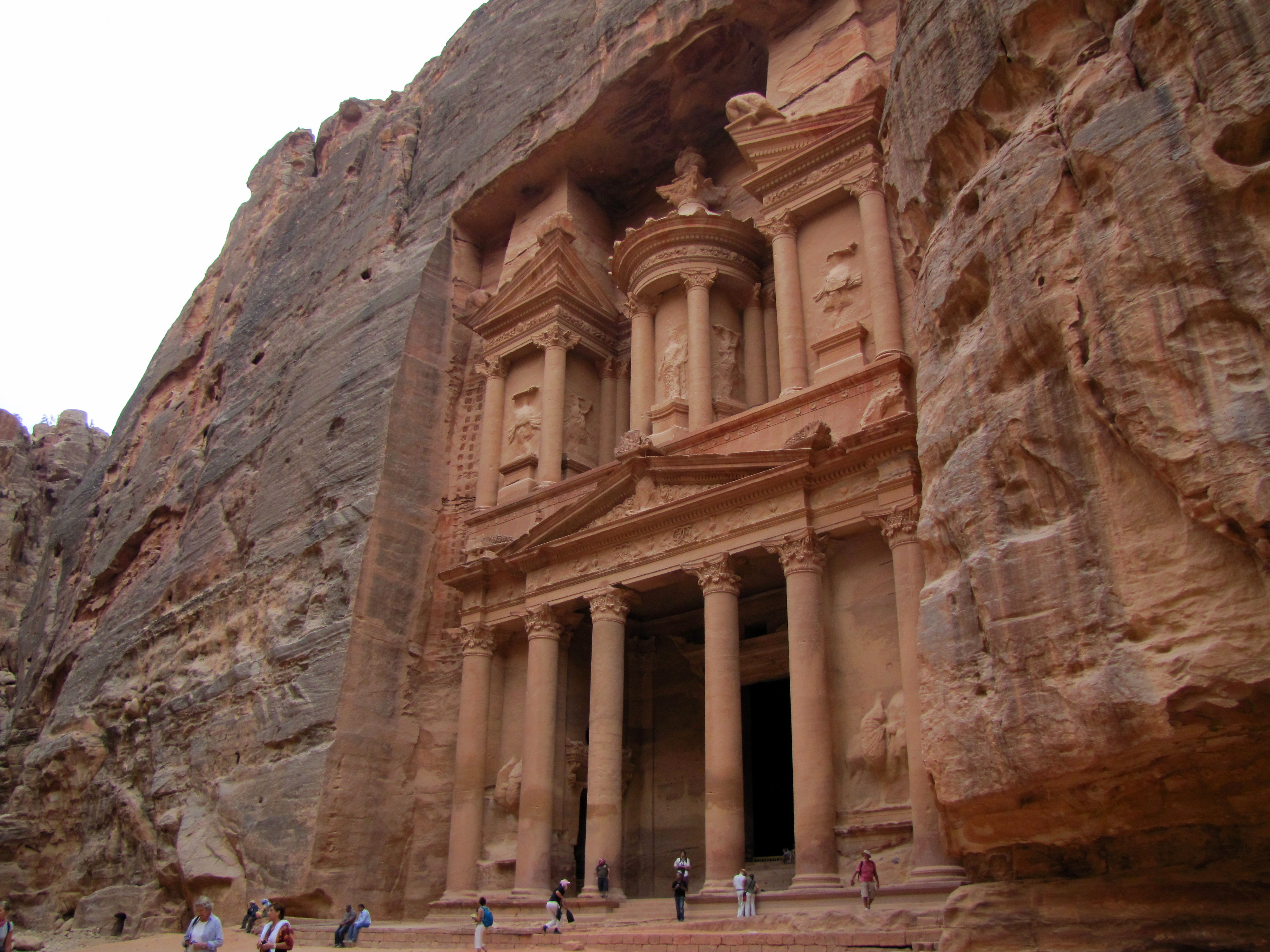Al-Khazneh, also known as “The Treasury,” stands as an emblem of Petra’s ancient grandeur, nestled within the Nabatean Kingdom’s rocky landscapes. This architectural marvel, carved into rose-red sandstone cliffs, captivates visitors with its enigmatic aura and rich historical significance. This article will give an overview of the secrets of Al-Khazneh and what is inside it.
The Majestic Facade
The facade of Al-Khazneh is a testament to the Nabateans’ architectural prowess and artistic finesse. Towering at over 40 meters in height, its intricate carvings and imposing columns mesmerize beholders, evoking a sense of awe and wonder. The intricate details etched into the sandstone depict a blend of Hellenistic, Egyptian, and indigenous Nabatean influences, reflecting the cosmopolitan nature of Petra’s ancient inhabitants.
Hidden Treasures Within
Beyond its magnificent facade lies a realm shrouded in mystery and intrigue. Al-Khazneh is rumored to have served as a tomb for a Nabatean king, though no definitive evidence has been uncovered to confirm this theory. Legend has it that hidden chambers and passageways lie concealed within its walls, holding untold secrets and treasures waiting to be discovered by intrepid explorers.
Echoes of History
As visitors venture deeper into the heart of Al-Khazneh, they are enveloped by the echoes of a bygone era. The flickering candlelight casts dancing shadows upon the ancient walls, imbuing the space with an ethereal ambiance. Each step taken reverberates with the footsteps of those who walked these hallowed halls centuries ago, leaving an indelible imprint upon the sands of time.
The Eternal Charm
Despite the passage of millennia, Al-Khazneh continues to cast its spell upon all who behold it. Its timeless beauty transcends cultural and temporal boundaries, serving as a testament to the enduring legacy of Petra and the ingenuity of its creators. Whether bathed in the golden hues of dawn or illuminated by the soft glow of twilight, The Treasury remains a beacon of wonder, inviting travelers to unravel its mysteries and forge a connection with the ancient past.
Al-Khazneh and what is inside it?
Nestled amidst the rugged landscape of Jordan lies Petra, an ancient city steeped in history and mystery. Carved into the rose-red cliffs of the region, Petra boasts an array of stunning architectural marvels that date back to the Nabatean kingdom of the 1st century AD. Among these remarkable structures stands the Monastery, known locally as Ad Deir, and the focal point of our exploration: the Treasury, or Al-Khazneh. This monumental construction, hewn from sandstone rock, captures the imagination of all who behold it, drawing countless visitors from around the globe to marvel at its grandeur.
While the exterior of the Treasury, with its intricate carvings and imposing façade, captivates the imagination, unfortunately, visitors cannot venture inside. The interior of Al-Khazneh is an empty chamber, devoid of any significant artifacts or features. Surprisingly, the Nabataeans, who meticulously carved Petra into the cliffs, focused their efforts primarily on the façade, leaving the interior unfinished.
The Iconic Symbol of Petra
Despite its lack of interior access, the Treasury remains the iconic symbol of Petra, thanks in part to its prominent appearance in pop culture, notably in the Indiana Jones franchise. This renowned monument serves as the main draw for millions of tourists who journey to the Rose City, eager to catch a glimpse of its awe-inspiring grandeur.
A Testament to Timeless Beauty
Standing proudly for over two millennia, Al-Khazneh showcases the remarkable preservation of its Hellenistic façade. Every intricate detail speaks volumes about the unparalleled craftsmanship of its creators. Visitors are left in awe as they marvel at the ancient wonder, a tangible link to Petra’s storied past.
The Royal Connection: King Aretas IV’s Necropolis
Speculation surrounds the purpose of Al-Khazneh, with many historians believing it to be the necropolis of King Aretas IV, one of the most prominent rulers of the Nabataean empire. While concrete evidence may be elusive, the grandeur and significance of the Treasury only add to its enigmatic allure.
The Fate of Petra: From Prosperity to Obscurity
Once a bustling trading hub and the capital of the Nabataean empire, Petra thrived between 400 B.C. and A.D. 106. However, the city eventually fell into decline and was abandoned, lost to the sands of time for centuries. Today, Petra stands as a hauntingly beautiful reminder of a bygone era, its ancient ruins a testament to the ebb and flow of history.
The Enigmatic Construction
The Treasury, or Al-Khazneh, stands as a testament to the ingenuity and craftsmanship of the ancient Nabateans. Carved into the sheer face of the rock, its intricate façade mesmerizes with its detailed ornamentation and imposing presence. Believed to have served as the mausoleum of King Aretas IV, the structure exudes an aura of mystery and reverence, shrouded in the sands of time.
A Timeless Icon of Petra
As one of the foremost attractions in Jordan, the Treasury holds a special place in the hearts of locals and tourists alike. Its allure transcends centuries, beckoning travelers to embark on a journey through history and culture. Each intricate carving and weathered stone whispers tales of bygone eras, inviting visitors to delve into the rich tapestry of Petra’s past.

Unveiling the Name: Al-Khazneh, The Treasury
In the early 19th century, the Bedouins of the region bestowed upon this awe-inspiring structure the name “Al-Khazneh,” meaning The Treasury. Legends abounded among the desert tribes, who believed that the imposing façade concealed untold riches within its hallowed chambers. Though the truth behind its moniker may remain elusive, the Treasury continues to captivate imaginations and inspire wonder, a timeless monument to the enduring legacy of Petra.
The Purpose of Al-Khazneh
As a Mausoleum and Crypt: Al-Khazneh, also known as “The Treasury,” was originally constructed as a mausoleum and crypt at the beginning of the first century AD during the reign of Aretas IV Philopatris. It served as a final resting place for revered individuals of the time, honoring their memory and legacy.
Legendary Treasuries: The Arabic title “Treasury” stems from a legend suggesting that bandits or pirates once hid their plunder within a stone urn atop the second level of Al-Khazneh. While this tale adds an aura of mystery to the monument, historical evidence suggests otherwise, with the urn being solid sandstone and bearing bullet damage from early 20th-century Bedouin attempts to access its supposed treasure.
Associated with Pharaonic Treasures: Another legend links Al-Khazneh to the time of Moses, suggesting it may have functioned as a repository for treasures belonging to the Egyptian Pharaoh. This legend, known as Khaznet Far’oun, adds to the mystique surrounding the monument’s origins and purpose.
Architectural and Sculptural Features
Erosion and Weathering: Over the millennia, much of Al-Khazneh’s architectural details have eroded away due to natural weathering and human activity. Despite this, the monument still stands as a testament to ancient craftsmanship and architectural ingenuity.
Sculptural Depictions: The sculptures adorning Al-Khazneh are believed to depict various mythological figures associated with the afterlife. From dancing Amazons with double-axes on the upper level to figures of four eagles symbolizing the transportation of souls, each carving adds layers of symbolism and significance to the structure.
Symbolism of Castor and Pollux: Flanking the entrance are statues of the twins Castor and Pollux, figures from Greek and Roman mythology who were believed to dwell both on Mount Olympus and in the underworld. Their presence adds to the mythological tapestry woven into the fabric of Al-Khazneh.
Despite the passage of time and the wear of the elements, Al-Khazneh continues to intrigue and captivate visitors with its rich history, intricate carvings, and enigmatic legends.
Burial of Aaron in Petra
Mount Hor and Aaron’s Burial: According to biblical accounts, Aaron, the brother of Moses, died and was buried on the summit of Mount Hor. The people mourned his passing for thirty days. Mount Hor is often identified with the mountain near Petra in Jordan, known in Arabic as Jabal Hārūn, which translates to “Aaron’s Mountain.” A mosque was constructed on the summit of this mountain in the 14th century, commemorating the biblical event. Motivation – Mind – Success – Thinking – Productivity – Happiness
Petra: The Rose City
Archaeological Marvel: Petra, hailed as one of the New Seven Wonders of the World, is a testament to ancient ingenuity and craftsmanship. Known as the “Rose City” due to the pink hues of its sandstone cliffs, Petra boasts a rich history spanning over a millennium.
Nabatean Civilization
Ingenious Builders: Petra’s architectural wonders are attributed to the Nabateans, a civilization that thrived in the region from the 3rd century BC to the 1st century AD. Over a span of 400 years, they meticulously designed and constructed the intricate complex of Petra, showcasing their remarkable organizational skills and architectural prowess.
Legacy of Petra: The labyrinthine city of Petra is a symbol of the Nabatean civilization’s achievements and cultural legacy. Its majestic rock-cut architecture, elaborate tombs, and grand monuments continue to awe and inspire visitors from around the world, preserving the memory of a bygone era of prosperity and innovation.
Other Recommended Reading
Post Views: 971

